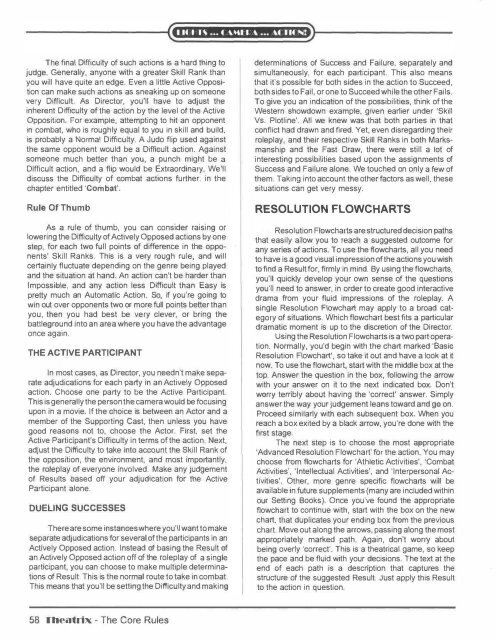Untitled - Index of - Free
Untitled - Index of - Free
Untitled - Index of - Free
You also want an ePaper? Increase the reach of your titles
YUMPU automatically turns print PDFs into web optimized ePapers that Google loves.
The final Difficulty <strong>of</strong> such actions is a hard thing to<br />
judge. Generally, anyone with a greater Skill Rank than<br />
you will have quite an edge. Even a little Active Opposi<br />
tion can make such actions as sneaking up on someone<br />
very Difficult. As Director, you'll have to adjust the<br />
inherent Difficulty <strong>of</strong> the action by the level <strong>of</strong> the Active<br />
Opposition. For example, attempting to hit an opponent<br />
in combat, who is roughly equal to you in skill and build,<br />
is probably a Normal Difficulty. A Judo flip used against<br />
the same opponent would be a Difficult action. Against<br />
someone much better than you, a punch might be a<br />
Difficult action, and a flip would be Extraordinary. We'll<br />
discuss the Difficulty <strong>of</strong> combat actions further, in the<br />
chapter entitled 'Combat'.<br />
Rule Of Thumb<br />
As a rule <strong>of</strong> thumb, you can consider raising or<br />
lowering the Difficulty <strong>of</strong> Actively Opposed actions by one<br />
step, for each two full points <strong>of</strong> difference in the oppo<br />
nents' Skill Ranks. This is a very rough rule, and will<br />
certainly fluctuate depending on the genre being played<br />
and the situation at hand. An action can't be harder than<br />
Impossible, and any action less Difficult than Easy is<br />
pretty much an Automatic Action. So, if you're going to<br />
win out over opponents two or more full points better than<br />
you, then you had best be very clever, or bring the<br />
battleground into an area where you have the advantage<br />
once again.<br />
THE ACTIVE PARTICIPANT<br />
In most cases, as Director, you needn't make sepa<br />
rate adjudications for each party in an Actively Opposed<br />
action. Choose one party to be the Active Participant.<br />
This is generally the person the camera would be focusing<br />
upon in a movie. If the choice is between an Actor and a<br />
member <strong>of</strong> the Supporting Cast, then unless you have<br />
good reasons not to, choose the Actor. First, set the<br />
Active Participant's Difficulty in terms <strong>of</strong> the action. Next,<br />
adjust the Difficulty to take into account the Skill Rank <strong>of</strong><br />
the opposition, the environment, and most importantly,<br />
the roleplay <strong>of</strong> everyone involved. Make any judgement<br />
<strong>of</strong> Results based <strong>of</strong>f your adjudication for the Active<br />
Participant alone.<br />
DUELING SUCCESSES<br />
There are some instances where you'll want to make<br />
separate adjudications for several <strong>of</strong> the participants in an<br />
Actively Opposed action. Instead <strong>of</strong> basing the Result <strong>of</strong><br />
an Actively Opposed action <strong>of</strong>f <strong>of</strong> the roleplay <strong>of</strong> a single<br />
participant, you can choose to make multiple determina<br />
tions <strong>of</strong> Result. This is the normal route to take in combat.<br />
This means that you'll be setting the Difficulty and making<br />
58 Theatrlx - The Core Rules<br />
determinations <strong>of</strong> Success and Failure, separately and<br />
simultaneously, for each participant. This also means<br />
that it's possible for both sides in the action to Succeed,<br />
both sides to Fail, or one to Succeed while the other Fails.<br />
To give you an indication <strong>of</strong> the possibilities, think <strong>of</strong> the<br />
Western showdown example, given earlier under 'Skill<br />
Vs. Plotline'. All we knew was that both parties in that<br />
conflict had drawn and fired. Yet, even disregarding their<br />
roleplay, and their respective Skill Ranks in both Marks<br />
manship and the Fast Draw, there were still a lot <strong>of</strong><br />
interesting possibilities based upon the assignments <strong>of</strong><br />
Success and Failure alone. We touched on only a few <strong>of</strong><br />
them. Taking into account the other factors as well, these<br />
situations can get very messy.<br />
RESOLUTION FLOWCHARTS<br />
Resolution Flowcharts are structured decision paths<br />
that easily allow you to reach a suggested outcome for<br />
any series <strong>of</strong> actions. To use the flowcharts, all you need<br />
to have is a good visual impression <strong>of</strong> the actions you wish<br />
to find a Result for, firmly in mind. By using the flowcharts,<br />
you'll quickly develop your own sense <strong>of</strong> the questions<br />
you'll need to answer, in order to create good interactive<br />
drama from your fluid impressions <strong>of</strong> the roleplay. A<br />
single Resolution Flowchart may apply to a broad cat<br />
egory <strong>of</strong> situations. Which flowchart best fits a particular<br />
dramatic moment is up to the discretion <strong>of</strong> the Director.<br />
Using the Resolution Flowcharts is a two part opera<br />
tion. Normally, you'd begin with the chart marked 'Basic<br />
Resolution Flowchart', so take it out and have a look at it<br />
now. To use the flowchart, start with the middle box at the<br />
top. Answer the question in the box, following the arrow<br />
with your answer on it to the next indicated box. Don't<br />
worry terribly about having the 'correct' answer. Simply<br />
answer the way your judgement leans toward and go on.<br />
Proceed similarly with each subsequent box. When you<br />
reach a box exited by a black arrow, you're done with the<br />
first stage.<br />
The next step is to choose the most appropriate<br />
'Advanced Resolution Flowchart' for the action. You may<br />
choose from flowcharts for 'Athletic Activities', 'Combat<br />
Activities', 'Intellectual Activities', and 'Interpersonal Ac<br />
tivities'. Other, more genre specific flowcharts will be<br />
available in future supplements (many are included within<br />
our Setting Books). Once you've found the appropriate<br />
flowchart to continue with, start with the box on the new<br />
chart, that duplicates your ending box from the previous<br />
chart. Move out along the arrows, passing along the most<br />
appropriately marked path. Again, don't worry about<br />
being overly 'correct'. This is a theatrical game, so keep<br />
the pace and be fluid with your decisions. The text at the<br />
end <strong>of</strong> each path is a description that captures the<br />
structure <strong>of</strong> the suggested Result. Just apply this Result<br />
to the action in question.



